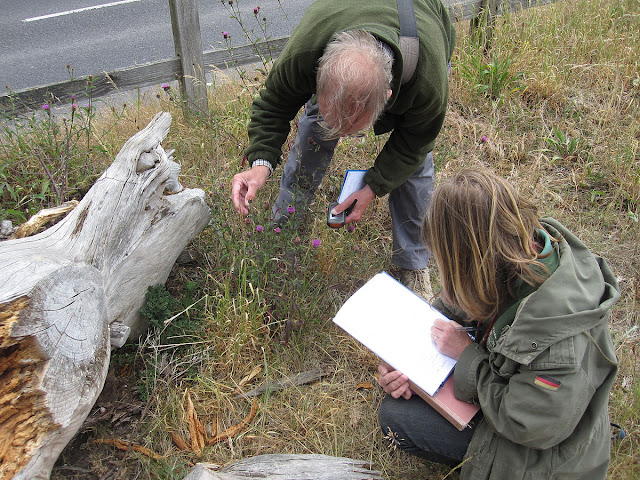 |
| The group starting to spread out on Keston Common, 28 May 2011. |
It was not a ramble, nor even really a walk, but a sort of slightly mobile study of the local plants and wildlife. The first photo was taken just outside the car park, and you can see the group already splitting up. Most of the time there were two groups with a few pairs and individuals moving around and between the groups.
It was a chilly and mostly overcast day, but there were occasional sunny breaks and we actually saw a lot more than I had expected. After the recent dry weather, some of the plants were desiccated or stunted, but that didn't affect the wet meadows or the bog. There are some very reliable springs in this area.
 |
| Crustose lichen on an oak tree, Keston Common, 28 May 2011. Identified by Ishpi Blatchley as probably Lecanora chlarotera. |
Even the dry area we started in had lots of interest. Sheep's sorrel and cat's-ear were flowering, and a few ox-eye daisies. There were lichens and mosses, grasses, and several vetches.
The second photo is a small patch of crustose lichen on an oak trunk. To the naked eye it could be a stain from a bird dropping, but closer examination shows the apothecia, reproductive bodies looking like craters with white rims.
The flowers had the same beetle population which I have seen elsewhere recently; lots of bright green Oedemera nobilis, browner Oedemera lurida, and Malachius bipustulatus, green with two red dots at the end of its wing cases.
 |
| The white flowers of hairy tare. Keston Common, 28 May 2011. |
The experts spent some time combing the ground around Keston's war memorial. I was looking around the back of the hedge, where some common cow wheat and herb robert were flowering. In the dry area by the road were some stunted cat's-ears and some mouse-ear hawkweed growing next to each other. The hawkweed has dandelion-like flowers, but of a lighter, fresher yellow. Ishpi, who is a lichen expert, was pleased by the excellent specimens of Parmelia saxatilis on the back of an old wooden seat.
We moved on to the Ravensbourne wet meadows. These were quite lovely, full of meadow buttercups. Around the edges and in the wetter areas were some real treats. Straight ahead of us was a patch of ragged robins, the same patch I photographed on a reptile walk two weeks ago, against a backdrop of hoary willowherb. Judy was anxiously searching for some black sedge, which used to be there; she found some a little way away. Along the edge here one of the predominant plants was water horsetail, just the fruiting bodies on the end of long green stems, looking very prehistoric.
 |
| Fruiting body of water horsetail, Equisetum fluviatile. On a wet Ravensbourne Meadow. 28 May 2011. |
Other meadow edges were quite different. To one side were large and showy clumps of wild yellow iris. This area of meadow also had wild angelica, woody nightshade, brooklime and the buttercup-like lesser spearwort.
Coming back through the woods we heard wren and blackcap song, and saw a goldcrest actually hovering among low branches after insects, almost like a hummingbird, most unusual behaviour and surely not energy-efficient.
Some of the group split off to examine the bog and the rest of us went to look at the ponds to see if there were any dragonflies or damselflies. We only saw one thing, but it was interesting; a damselfly that had recently emerged and had not yet taken its full mature state. The experts thought it was most likely a red-eyed damsefly, known to inhabit that area of the pond. It was on the flower of a water hawthorn.
Walking back towards the car park we saw some clumps of heath rush, scarce in this part of the country.
Some more images:
 |
| Identifying and recording common knapweed, Centauria nigra. Keston common, 28 May 2011. |
 |
| Parmelia saxatilis on a roadside seat. Keston, 28 May 2011. The greenish lichen on the right of the main patch is Flavoparmelia caperata. |
 |
| Flower of Herb Robert, Geranium robertianum, behind Keston war memorial. 28 May 2011. A white flowered variety; they are usually more or less pink. |
 |
| Common cow wheat, Melampyrum pratense, flowering on the edge of Keston Common. 28 May 2011. |
 |
| Brooklime, Veronica beccabunga, on a wet Ravensbourne Meadow. 28 May 2011. |
 |
| A clump of yellow iris, Iris pseudacorus, on a wet Ravensbourne Meadow. 28 May 2011. |
 |
| A flower of the yellow iris, Iris pseudacorus, on a wet Ravensbourne Meadow. 28 May 2011. |
 |
| Cantharis pellucida, a soldier beetle, in a wet Ravensbourne Meadow. 28 May 2011. |
 |
| Insect eggs, probably a moth, on the underside of a willow leaf by the middle Keston pond. 28 May 2011. |
 |
| Heath rush, Juncus squarrosus, near Keston Ponds. 28 May 2011. |

By the time you're done, you'll have a book, possibly destined to fame in the community. Others can list, to be sure, but few photograph anywhere near as well. I have started thinking of the meadows of greater London in the same terms as Pevsner's Buildings of England.
ReplyDelete